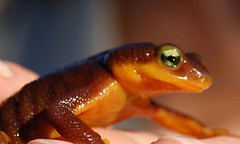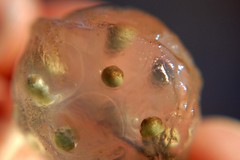Special thanks to Megan Platt and Rosemary Cameron of the East Bay Regional Parks District for their participation.
Lauren Sommer contributed to this Exploration.
California Newts
 One of the most unique species found in Briones Regional Park is the California Newt (Taricha torosa). With a brown dorsal and bright orange belly, they look almost exactly the same as another amphibian found in the park, the rough-skinned newt (Taricha granulosa). Their coloring isn't just for decoration. California newts are actually poisonous. They contain tetrodotoxin, or TTX, the same neurotoxin found in pufferfish. The toxin acts as a deterrent against predators, but recently, scientists discovered that one predator, the garter snake, had found an advantage. Charles T. Hanifin, an evolutionary biologist at Stanford, and colleagues studied 20,000 garter snakes and 500 newts in habitats along the Pacific Coast. They discovered in four areas, garter snakes had developed a resistance to the newts' poison. One of the areas is Briones Reservoir, directly next to Briones Regional Park. This toxic arms race between species is known as "co-evolution."
One of the most unique species found in Briones Regional Park is the California Newt (Taricha torosa). With a brown dorsal and bright orange belly, they look almost exactly the same as another amphibian found in the park, the rough-skinned newt (Taricha granulosa). Their coloring isn't just for decoration. California newts are actually poisonous. They contain tetrodotoxin, or TTX, the same neurotoxin found in pufferfish. The toxin acts as a deterrent against predators, but recently, scientists discovered that one predator, the garter snake, had found an advantage. Charles T. Hanifin, an evolutionary biologist at Stanford, and colleagues studied 20,000 garter snakes and 500 newts in habitats along the Pacific Coast. They discovered in four areas, garter snakes had developed a resistance to the newts' poison. One of the areas is Briones Reservoir, directly next to Briones Regional Park. This toxic arms race between species is known as "co-evolution."
Newt Migration
 As amphibians, California newts spend their lives both on land and in the water. Every year, beginning in December or January, the newts leave their dwellings on land and make a migration to ponds or bodies of water for mating season. During this time of year, newts can be seen on trails and roads in many parks throughout the East Bay. In fact, South Park drive in Tilden Regional Park is closed each year during newt mating season. Local rangers found that so many newts were being crushed by cars while migrating, they recommended closing the road between November and April.
As amphibians, California newts spend their lives both on land and in the water. Every year, beginning in December or January, the newts leave their dwellings on land and make a migration to ponds or bodies of water for mating season. During this time of year, newts can be seen on trails and roads in many parks throughout the East Bay. In fact, South Park drive in Tilden Regional Park is closed each year during newt mating season. Local rangers found that so many newts were being crushed by cars while migrating, they recommended closing the road between November and April.
Newt Love
 Once they arrive in the ponds, the newts mate and females lay their eggs in a tight ball. It may seems surprising that newts spend this part of their lives in stock ponds - ponds that were created for and are used by cattle. In a recent study though, biologists found that stock ponds are actually more ideal habitats for some amphibians like tiger salamanders, also found in East Bay parks. The cattle keep dense brush from forming on the edges of the ponds, which can be difficult for the small salamanders to get through. Cattle also stir up the pond waters, making them murkier. This can actually protect young salamanders and newts, often preyed upon by giant water bugs (also known as toe-biters). The muddy water provides useful cover for the larval amphibians.
Once they arrive in the ponds, the newts mate and females lay their eggs in a tight ball. It may seems surprising that newts spend this part of their lives in stock ponds - ponds that were created for and are used by cattle. In a recent study though, biologists found that stock ponds are actually more ideal habitats for some amphibians like tiger salamanders, also found in East Bay parks. The cattle keep dense brush from forming on the edges of the ponds, which can be difficult for the small salamanders to get through. Cattle also stir up the pond waters, making them murkier. This can actually protect young salamanders and newts, often preyed upon by giant water bugs (also known as toe-biters). The muddy water provides useful cover for the larval amphibians.
The Park's History
In the 1800's, most of Briones was working ranchland. In 1829, Felipe Briones built a homestead in Briones on the cattle ranch known as Rancho Boca de la Canada del Pinole. When Briones was killed in 1840, and his widow, Maria Manuela Valencia Briones, petitioned California Governor Alvarado for a land grant in her name. California was then part of Mexico, and when it became a state, Maria Briones' grant was called into question. The US Supreme Court finally upheld her grant in 1860.
In the subsequent decades, Briones continued as a ranch under several owners who developed orchards and cultivated fruit, as much of Contra Costa County was used in that time. Around the turn of the century, the People's Water Company (later acquired by the East Bay Municipal Utility District) purchased Briones. The nearby San Pablo Dam was constructed in 1923. The East Bay Regional Parks District later acquired Briones and opened the park in 1967. Even today, parts of Briones are still used by cattle herds for grazing. With summer heat and dry grasses, fire danger is a major concern for the park district. Through managed grazing with both cattle and goats, park managers are able to keep this fuel load down.
Hiking Tips
With its rolling hills and narrow creeks, Briones Regional Park is nestled in the East Bay Hills. The park is home to a broad range of wildlife, from squirrels and dear, to turkey vultures, red-tailed hawks and California Newts. Hikes should also be aware of rattlesnakes and the occasional mountain lion. There are six species of native oak trees in the park, from Valley Oaks to the more rare Blue Oaks. As a transitional area, Briones is home to species from both the California coastal habitats and the interior habitats of the Central Valley and Sierra foothills.
Events in Briones Regional Park
The East Bay Regional Park District offers a number of activities in Briones Regional Park and many other nearby parks. Check out their website for guided hikes, events, and classes to sharpen your outdoor skills.
Learn More About Wildlife
If you're interested in learning more about the wildlife of the East Bay, the Tilden Nature Area programs offers many options in Berkeley's Tilden Regional Park. Take a guided hike with a naturalist to search for the local flora and fauna, including the local California Newts.
Volunteer in Briones
Briones Regional Park and many others rely on local volunteers to maintain the trails and do habitat restoration. There are even opportunities in their wildlife program. Learn more about how to volunteer.
Latest Visitor Photos
Join the Briones Regional Park photo group on Flickr to share your photos of this amazing place.
Additional Links


